Welcome to the captivating world of Norse mythology, where ancient tales and divine beings intertwine.
Today, we delve into the profound symbolism and mythological significance of Yggdrasil, the World Tree that stands at the center of this rich folklore.
Yggdrasil, the World Tree of Norse mythology, serves as a central symbol representing the interconnectedness of the nine realms and embodying themes of cyclical renewal and cosmic harmony. Its mythology intricately weaves together the story of its roots tapping into wells of cosmic wisdom, its connection to Ragnarok, and its enduring legacy in popular culture, literature, and art, reminding us of the timeless power of Norse mythology in understanding the world and our place within it.
Prepare to be enchanted as we unveil the secrets hidden within its branches and roots.
Key Takeaways:
- Yggdrasil is a central symbol in Norse mythology, known as the World Tree.
- It represents the interconnectedness of the nine realms in the Norse cosmos.
- The branches of Yggdrasil extend across the heavens, while its roots delve deep into different realms.
- Yggdrasil’s mythology encompasses the web of cosmic wisdom, various realms, and mythical creatures.
- Its enduring legacy continues to inspire and fascinate people today.
The Mythical Significance of Yggdrasil in Norse Cosmology
Yggdrasil, the Norse mythological World Tree, holds a place of profound significance in the intricate tapestry of Norse mythology.
It serves as a sacred conduit linking the realms of gods, humans, giants, and other mythical beings, embodying the interconnectedness of all things.
At the heart of Yggdrasil’s majestic presence lie its roots, delving deep into mystical wells of cosmic wisdom.
These wells include the well of Urd in Asgard, where the three norns shape the lives of men, the well of Mimir in Jotunheim, bestowing supreme wisdom to those who drink from it, and the wellspring of Hvergelmir in Niflheim, symbolizing the primordial source of life and creation.
The branches of Yggdrasil span across the vast expanse of Norse mythology, reaching out to the realms of Asgard, Midgard, Vanaheim, Alfheim, Jotunheim, Svartalfheim, Muspelheim, and Helheim.
Each realm possesses its own distinct characteristics, inhabitants, and mythological significance, contributing to the vibrant tapestry of Norse lore.
As the mythological World Tree, Yggdrasil serves as a powerful symbol of unity and cosmic harmony, reflecting the deeply ingrained interconnectedness within the Norse belief system.
Its presence resonates with themes of cyclical renewal and regeneration, emphasizing the eternal cycles of life and death.
Through the story of Yggdrasil, Norse mythology beautifully portrays the intricate relationships between gods, giants, humans, and the rich tapestry of mythical creatures.
This sacred tree stands tall, linking the realms, and encapsulating the depth and complexity of Norse cosmology.
The Story of Yggdrasil and Its Roots

Yggdrasil’s myth story is intricately woven with the roots that anchor this mighty World Tree in Norse folklore.
Each of these roots plays a vital role in connecting Yggdrasil to different realms and sources of cosmic power.
The First Root: Asgard and the Well of Urd
The first root stretches up to Asgard, the realm of the gods, and taps into the well of Urd.
This well is guarded by the three norns, who shape the destinies of all beings, including humans.
It is here that the threads of life and fate are spun, representing the interconnectedness of all things.
The Second Root: Jotunheim and the Well of Mimir
Yggdrasil’s second root extends to Jotunheim, the land of giants. This root plunges deep into the well of Mimir, a source of immense wisdom.
Those who dare to drink from Mimir’s well gain access to unparalleled knowledge and insight, making this root a symbol of enlightenment.
The Third Root: Niflheim and the Wellspring of Hvergelmir
The third root of Yggdrasil travels to Niflheim, the realm of the dead. Here, it taps into the wellspring of Hvergelmir, an ominous and primordial source of life and creation.
This root symbolizes the cyclical nature of existence, as life emerges from the depths of death and destruction.
These roots of Yggdrasil serve as the conduit through which the energies and wisdom of different realms flow, emphasizing the interconnectedness between gods, giants, and the realms of the dead.
They form the foundation upon which Yggdrasil’s mythological significance and power are built.
Yggdrasil: Roots symbolizing the interconnectedness between realms in Norse mythology.
The Realms Connected by Yggdrasil
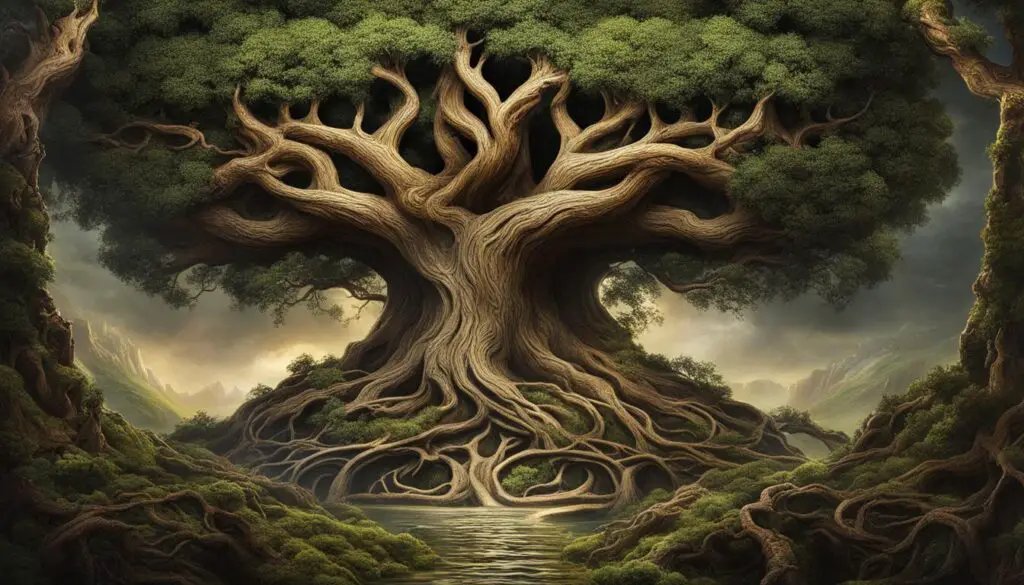
In Norse mythology, Yggdrasil serves as a gateway between various realms, linking together a vibrant and diverse cosmos.
Apart from Asgard, Midgard, and Niflheim, Yggdrasil connects realms such as Vanaheim, Alfheim, Jotunheim, Svartalfheim, Muspelheim, and Helheim.
Each realm possesses its own unique characteristics, inhabitants, and significance within the rich tapestry of Norse mythology.
Asgard: Asgard is the realm of the Aesir gods, where divine beings such as Odin, Thor, and Freya reside.
It is a place of power and majesty, serving as the home of the gods and the seat of their cosmic rule.
Midgard: Midgard is the realm of humankind, situated at the center of the Norse cosmos.
It is the world of mortals, where humans make their homes, forge their destinies, and interact with the gods and mythical creatures.
Niflheim: Niflheim is the icy realm of the dead, a frozen wasteland where the souls of those who die reside.
It is a place of darkness and cold, representing the eternal cycle of death and rebirth.
Vanaheim: Vanaheim is the realm of the Vanir gods, a lush and fertile land known for its abundance of natural resources and enchanting beauty.
The Vanir gods, including Njord and Freyr, are associated with fertility, nature, and prosperity.
Alfheim: Alfheim is the realm of the light elves, ethereal beings known for their radiant beauty and grace.
It is a realm of enchantment and magic, where light and goodness prevail.
Jotunheim: Jotunheim is the land of giants, a rugged and formidable realm inhabited by powerful and ancient beings.
Giants such as Thrym and Surtur play significant roles in Norse mythology, often challenging the gods and shaping the course of events.
Svartalfheim: Svartalfheim is the realm of the dark elves, mysterious and cunning creatures skilled in magic and craftsmanship.
Known for their ability to forge powerful weapons and artifacts, the dark elves have a complex relationship with the gods and humans.
Muspelheim: Muspelheim is the realm of fire, a fiery and chaotic land inhabited by fire giants such as Surtr.
It represents the primal forces of creation and destruction, symbolizing the power and unpredictability of nature.
Helheim: Helheim is the realm of the dead ruled by the goddess Hel. It is a realm of shadows and darkness, where souls who are not granted a place in Valhalla or other celestial realms are destined to reside for eternity.
The interconnectedness of these realms, facilitated by Yggdrasil, forms the foundation of Norse mythology.
Each realm contributes to the overarching narrative, with gods, giants, elves, and other mythical creatures weaving together a vibrant tapestry of stories and legends.
Yggdrasil and Its Inhabitants
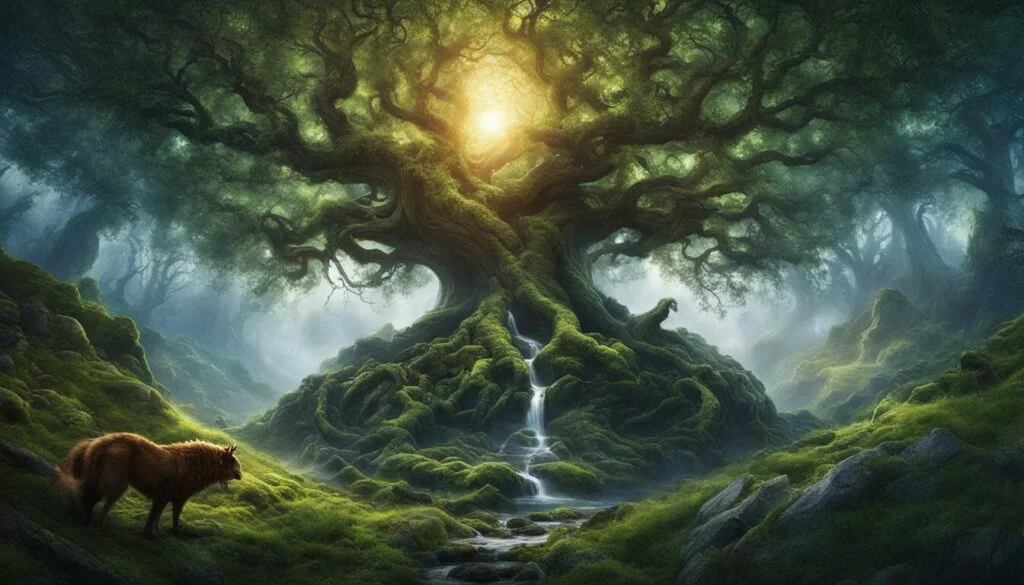
Yggdrasil, the World Tree of Norse mythology, is not merely a physical entity but also home to a host of mythical creatures that add depth and intrigue to the story.
These inhabitants contribute to the vivid and complex tapestry of Norse mythology, making Yggdrasil a captivating and dynamic symbol in Norse lore.
Nidhoggr: The Colossal Dragon of Decay
Nidhoggr, an enormous dragon, gnaws relentlessly at the roots of Yggdrasil, symbolizing decay and destruction.
This fearsome creature embodies the forces that seek to undermine and unravel the cosmic order represented by the World Tree.
An Eagle: The Embodiment of Knowledge and Inaction
An eagle perches majestically on the highest branches of Yggdrasil, symbolizing both knowledge and inaction.
This wise and observant creature represents the pursuit of wisdom and the immovable nature of cosmic forces.
Ratatoskr: The Messenger of Hate
The mischievous squirrel Ratatoskr serves as a messenger between Nidhoggr and the eagle, constantly fueling their mutual hatred and animosity.
This cunning creature adds a touch of intrigue to the narrative, always instigating and perpetuating conflict within the World Tree.
The presence of these mythical inhabitants within Yggdrasil reinforces the intricate and interconnected nature of Norse mythology.
They embody concepts such as decay, wisdom, and conflict, adding complexity and depth to the overarching narrative of the World Tree.
The Symbolism and Meaning of Yggdrasil
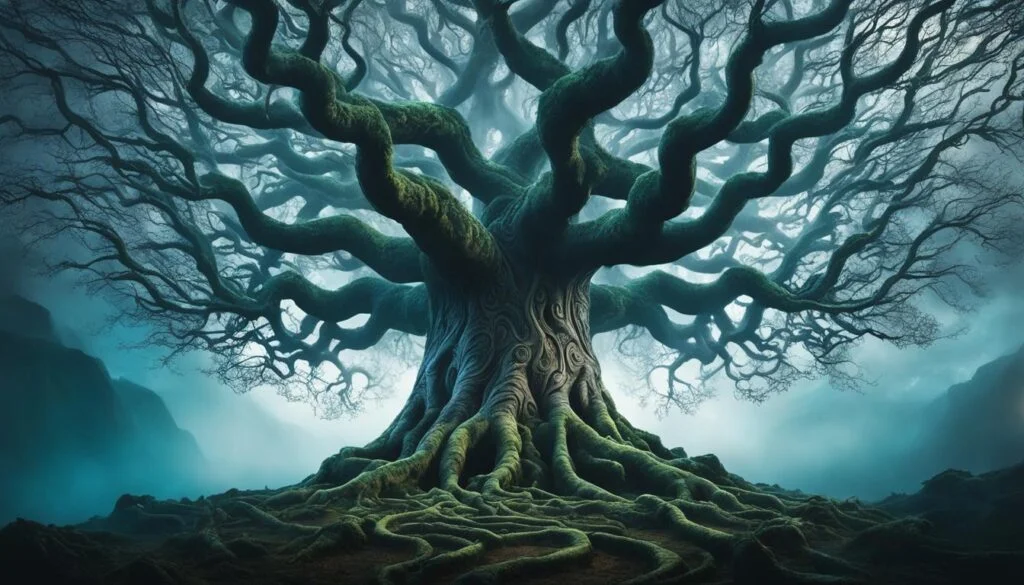
Yggdrasil, the World Tree of Norse mythology, holds profound symbolism and meaning within the cosmic tapestry of Norse beliefs.
It represents the interconnectedness of all things in the vast cosmos, emphasizing the unity and interdependence of the realms.
As the axis mundi, Yggdrasil serves as a nexus where the physical and spiritual worlds converge, transcending the boundaries of existence.
At its core, Yggdrasil embodies the cyclical nature of life, death, and rebirth, signifying the eternal renewal and regenerative cycles that permeate the Norse mythological framework.
Just as the tree sheds its leaves in the autumn, only to bloom anew in the spring, Yggdrasil encapsulates the unending cycle of creation, destruction, and subsequent resurgence.
The symbolism of Yggdrasil extends beyond its representation of the cosmic cycles. It also reflects the innate human desire to seek meaning and connection.
Humans have long sought to understand their place in the universe, and Yggdrasil’s image resonates deeply with this quest for purpose and interconnectivity.
It symbolizes the perennial search for wisdom, spiritual growth, and enlightenment, encouraging individuals to delve into the depths of their own personal journeys.
The Axis Mundi: Bridge between Realms
Yggdrasil serves as a cosmic bridge, connecting the various realms of the Norse mythological cosmos.
Its immense branches span across the heavens, while its roots delve deep into the realms below, touching legendary wells and streams.
This connection highlights the fundamental interconnectedness of the Norse cosmos, reinforcing the idea that all realms and beings are fundamentally linked.
The Immutable Tree of Life
As a world tree, Yggdrasil is a symbol of stability and permanence amidst the ever-changing world.
Its enduring presence signifies the everlasting nature of life and the cosmos itself. Yggdrasil stands tall and unwavering, bearing witness to the ebb and flow of the realms it connects, a steadfast reminder of the timeless power and significance of Norse mythology.
- Niflheim: Signifying the primordial source of life and creation, the roots of Yggdrasil tap into the wellspring of Hvergelmir, the embodiment of the forces that predate the world.
. - Jotunheim: The roots extend into the realm of giants, tapping into the well of Mimir. Drinking from this well offers supreme wisdom and insight, revealing the importance of knowledge and understanding.
. - Asgard: The roots intertwine with the well of Urd, where the three norns shape the destiny of humankind. This connection symbolizes the intricate web woven by fate and highlights the vital role of choices and consequences.
Yggdrasil’s symbolism and mythological significance continue to captivate and inspire, reminding us of our place in the interconnected web of existence.
Its timeless charm and profound meaning continue to leave an indelible mark on Norse culture and the collective human imagination.
The Importance of Yggdrasil in Norse Beliefs
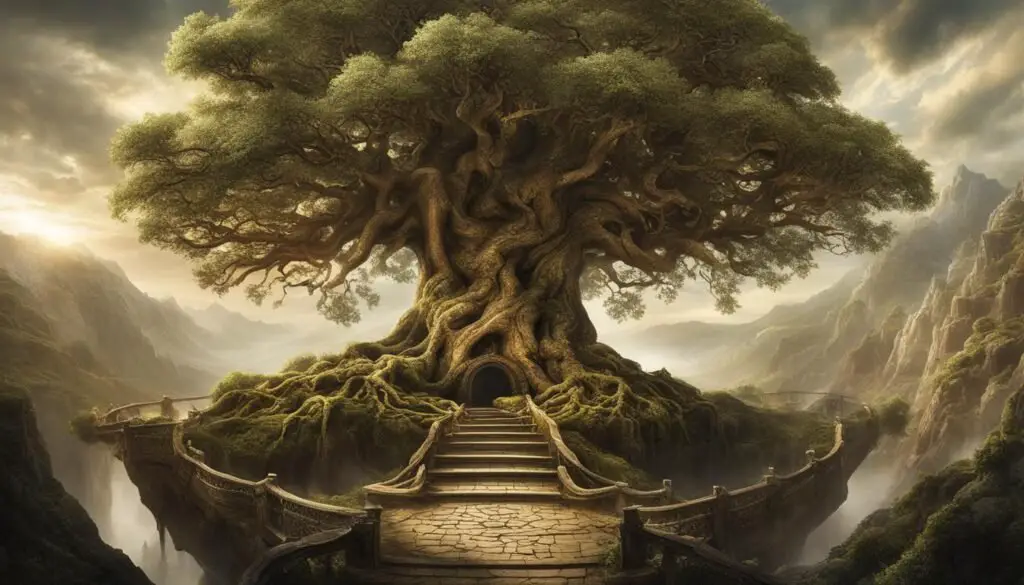
Yggdrasil, the mythical World Tree, holds tremendous significance in Norse beliefs and serves as a guiding framework for understanding the cosmos and one’s place within it.
This ancient tree symbolizes the connection between mortals and divine beings, exemplifying the flow of wisdom and the cycles of life.
The mythology surrounding Yggdrasil imparts essential lessons on sacrifice, the pursuit of wisdom, and the interconnectedness of all things.
The Norse people deeply revered Yggdrasil, and their reverence for this majestic tree underscores the profound significance of nature and the natural world in their culture.
Yggdrasil’s roots, branches, and inhabitants embody the interplay between gods, giants, and mythical creatures, weaving a complex tapestry of Norse mythology.
At the heart of Norse beliefs, Yggdrasil stands tall as a steadfast reminder of the fundamental connection between humanity and the natural world.
Its enduring presence in Norse mythology offers a timeless testament to the intertwined relationship between mortals and the divine, encouraging a deep appreciation for the wisdom that flows through the intricate branches of Yggdrasil.
The Flow of Wisdom and Life
- Yggdrasil embodies the flow of wisdom as its roots tap into legendary wells, granting access to cosmic knowledge and insight.
. - The branches of Yggdrasil extend across the nine realms, connecting beings from gods to humans, giants, and more.
. - The cyclical nature of Yggdrasil’s existence symbolizes the eternal cycle of life, death, and rebirth, emphasizing the interconnectedness of all things.
Lessons of Sacrifice and Interconnectedness
- Yggdrasil’s mythology teaches the importance of sacrifice, as the gods willingly offer parts of themselves to maintain the tree’s vitality and preserve the balance of the cosmos.
. - The interconnectedness represented by Yggdrasil emphasizes the interdependent relationship between different realms and beings, highlighting the significance of unity and collaboration.
. - By recognizing and honoring the interconnectedness of all things, Norse believers sought to maintain harmony and balance in their lives and in the world around them.
The enduring legacy of Yggdrasil in Norse beliefs reflects the timeless allure and wisdom of Norse mythology.
It reminds us of the profound connection between humanity and the natural world, inviting us to embrace the cycles of life, seek wisdom, and strive for interconnectedness in our own lives.
Yggdrasil and Ragnarok
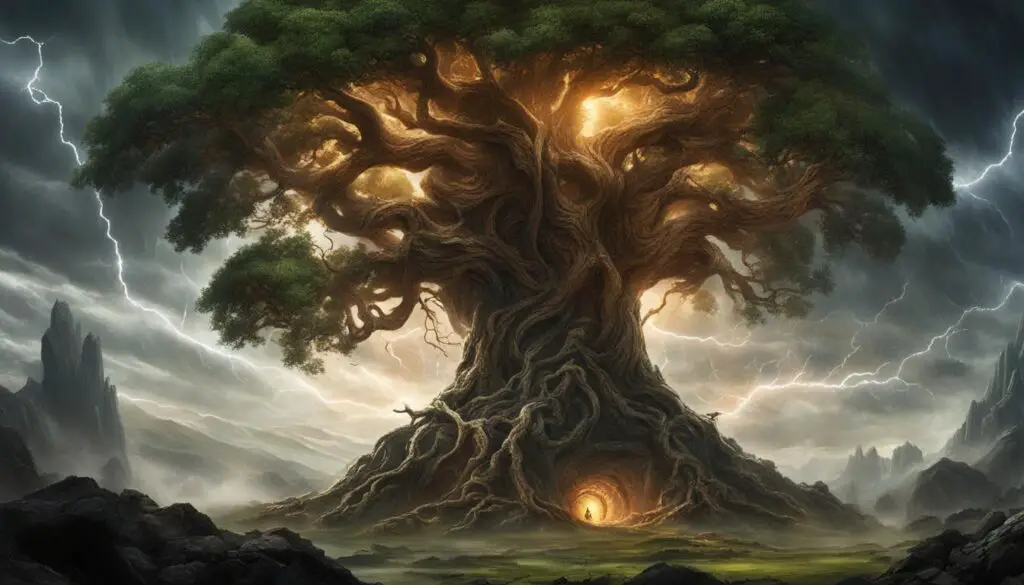
Yggdrasil, the legendary World Tree of Norse mythology, is inextricably intertwined with the prophecy of Ragnarok.
This cataclysmic event heralds the destruction and subsequent rebirth of the entire cosmos.
As Ragnarok unfolds, the mighty branches of Yggdrasil tremble violently, unleashing widespread devastation across the nine realms of the Norse mythos.
The exact fate of Yggdrasil during Ragnarok remains shrouded in mystery. However, it is believed that despite enduring intense turmoil, the World Tree survives the cataclysm, symbolizing the resilience of life and the eternal cycles of creation and destruction.
After the apocalyptic event concludes, Yggdrasil is said to give birth to new life, embodying the enduring power and regenerative forces at the core of Norse mythology.
Amidst the chaos of Ragnarok, Yggdrasil’s connection to this pivotal event underscores its pivotal role within Norse mythology.
It serves as a reminder of the cyclical nature of existence, where life, death, and rebirth intertwine in an eternal dance.
Yggdrasil’s enduring presence and resilience in the face of Ragnarok encapsulate the profound themes and timeless power of Norse mythologies.
Yggdrasil’s Enduring Legacy
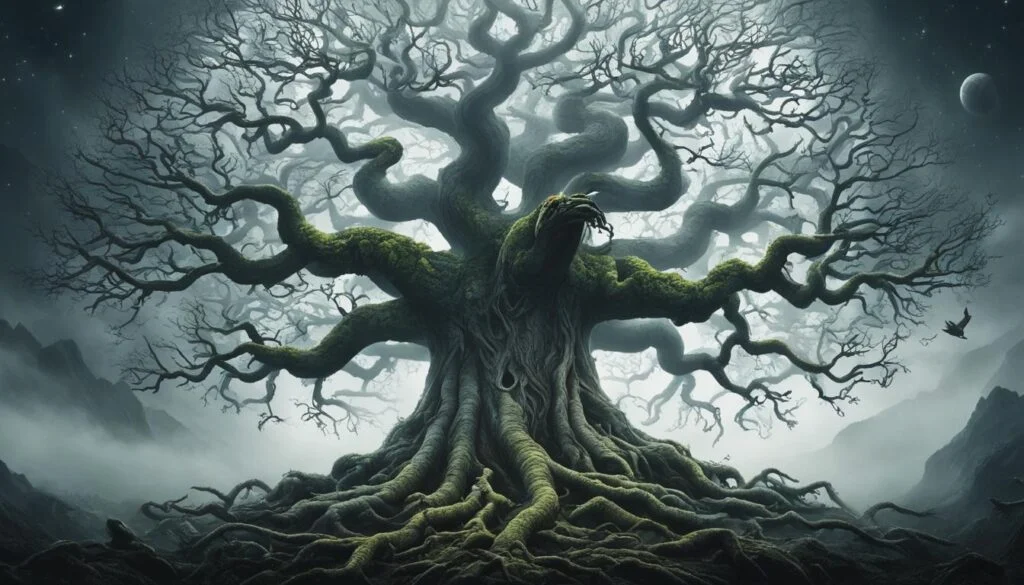
Yggdrasil, the legendary World Tree of Norse myth, continues to captivate and inspire people today.
Its symbolism and mythological significance have left a profound impact on popular culture, literature, and art.
The story of Yggdrasil reminds us of the grandeur and complexity of Norse mythology.
It embodies timeless themes such as sacrifice, interconnectedness, and the cyclical nature of existence.
As the cosmic axis, Yggdrasil represents the interconnectedness of all things, spanning across the nine realms of the Norse cosmos.
Yggdrasil’s enduring legacy is a testament to the enduring fascination with Norse mythology and its rich tapestry of gods, giants, and mythical creatures.
Its imagery and symbolism continue to shape our understanding of the cosmos and our place within it.
The profound significance of Yggdrasil resonates with people, serving as a reminder of the importance of nature, wisdom-seeking, and the eternal cycles of life and death.
Yggdrasil’s influence can be seen in various forms of artistic expression. It has inspired countless works of literature, from epic poems to fantasy novels, where its presence evokes a sense of wonder and enchantment.
Artists and illustrators have brought Yggdrasil to life, capturing its magnificence and intricacy in stunning visual representations.
The Influence of Yggdrasil in Popular Culture
- ✅ Yggdrasil is a recurring theme in contemporary fantasy literature, serving as a source of inspiration for authors writing about mythical worlds and epic quests.
- ✅ Video games often feature Yggdrasil as a central element, allowing players to explore the realms connected by the World Tree and interact with its inhabitants.
- ✅ In music, Yggdrasil is referenced in lyrics and album artwork, symbolizing the cosmic forces and profound mysteries that inspire musicians.
The enduring legacy of Yggdrasil speaks to the timeless allure of Norse mythology.
It captures the imagination, inviting us to delve into a world of gods, giants, and mythical creatures.
Yggdrasil’s mythological significance and symbolism continue to resonate, reminding us of the power of storytelling and the enduring connection between humanity and the natural world.
Conclusion
Yggdrasil, the World Tree of Norse mythology, stands as a profound symbol within the intricacies of Norse beliefs and Norse mythology.
Serving as a connective force between realms, it epitomizes the concept of interconnectedness and represents the eternal cycle of renewal.
The tale of Yggdrasil is a testament to the deep bond between humanity and nature, the relentless pursuit of wisdom, and the inevitable cycles of life and death.
Its enduring legacy continues to captivate and inspire, underscoring the timeless power of mythology in our understanding of the world.
The mythical significance of Yggdrasil lies in its ability to bridge the gap between gods, humans, giants, and other mythical beings.
Its roots tap into cosmic wells of wisdom and life-giving forces, while its branches reach across various realms, shaping the vibrant tapestry of Norse mythology.
As the central axis of the Norse cosmos, Yggdrasil represents a universal concept found in many mythologies: the axis mundi.
This symbolizes the convergence of the physical and spiritual realms, creating a sacred space where divine and mortal entities converge.
In the Norse belief system, Yggdrasil plays a vital role in shaping their understanding of the cosmos and their place within it.
It inspires reverence and awe, teaching valuable lessons of sacrifice, interconnectedness, and the power of nature.
Yggdrasil’s inseparable tie to the prophecy of Ragnarok, the cataclysmic event that brings about the end and rebirth of the world, highlights its enduring power and the cyclical nature of existence.
The story of Yggdrasil continues to permeate popular culture, art, and literature, serving as a reminder of the deep-rooted fascination and timeless relevance of Norse mythology.
FAQ
What is the story of Yggdrasil, the World Tree, in Norse mythology?
Yggdrasil, also known as the Tree of Life, is a central symbol in Norse mythology. It serves as a cosmic axis, connecting the nine realms of the Norse cosmos. Its immense branches extend across the heavens, while its roots delve deep into different realms, tapping into legendary wells and streams. Yggdrasil holds great cosmic significance and is a powerful representation of the interconnectedness of all things in Norse mythology.
What is the mythological significance of Yggdrasil in Norse cosmology?
Yggdrasil is a sacred tree that holds immense mythological significance in the Norse cosmology. It serves as a conduit between the realms of gods, humans, giants, and other beings. Yggdrasil’s roots tap into wells of cosmic wisdom, such as the well of Urd in Asgard, the well of Mimir in Jotunheim, and the wellspring of Hvergelmir in Niflheim. The branches of Yggdrasil extend to various realms, including Asgard, Midgard, Vanaheim, Alfheim, Jotunheim, Svartalfheim, Muspelheim, and Helheim. Each realm has its own unique characteristics and inhabitants, contributing to the vibrant tapestry of Norse mythology.
What is the story of Yggdrasil and its roots in Norse folklore?
Yggdrasil’s roots play a significant role in its mythology. The first root reaches up to Asgard, the realm of the gods, and taps into the well of Urd, where the three norns shape the lives of men. The second root extends to Jotunheim, the land of giants, and taps into the well of Mimir, granting supreme wisdom to those who drink from it. The third root travels to Niflheim, the realm of the dead, and taps into the wellspring of Hvergelmir, symbolizing the primordial source of life and creation. These roots highlight the interconnectedness between different realms and beings in Norse mythology.
Which realms are connected by Yggdrasil, the World Tree?
Yggdrasil serves as a gateway between various realms in Norse mythology. Along with Asgard, Midgard, and Niflheim, Yggdrasil links realms such as Vanaheim, Alfheim, Jotunheim, Svartalfheim, Muspelheim, and Helheim. Each realm has its own unique characteristics, inhabitants, and significance within the Norse mythological framework. Asgard is the realm of the Aesir gods, Midgard is the realm of humankind, and Niflheim is the icy realm of the dead. The other realms are inhabited by different divine beings and creatures, contributing to the rich and diverse world of Norse mythology.
Who are the inhabitants of Yggdrasil, the World Tree, in Norse mythology?
Yggdrasil is not only a physical entity but is also inhabited by various mythical creatures. Nidhoggr, a colossal dragon, gnaws at the roots of the tree, representing decay and destruction. An eagle perches on Yggdrasil’s highest branches, embodying knowledge and inaction. The squirrel Ratatoskr acts as a messenger between Nidhoggr and the eagle, fanning the flames of hate between them. These inhabitants contribute to the vivid and complex tapestry of Norse mythology, adding depth and intrigue to the story of Yggdrasil.
What is the symbolism and meaning of Yggdrasil in Norse mythology?
Yggdrasil is a profound symbol in Norse mythology, representing the interconnectedness of all things in the cosmos. It embodies the cyclical nature of life, death, and rebirth, underscoring the idea of continuous renewal and regeneration. As a world tree, it also symbolizes the axis mundi, a universal concept found in many mythologies, where the physical and spiritual realms meet. Yggdrasil’s image resonates deeply with human existence, reflecting the innate human desire to seek meaning and connectivity.
What is the importance of Yggdrasil in Norse beliefs?
Yggdrasil plays a vital role in the belief system of the Norse people. It offers a framework for understanding the cosmos and one’s place within it. Yggdrasil represents the connection between mortals and divine beings, the flow of wisdom, and the cycles of life. Its mythology teaches lessons of sacrifice, wisdom-seeking, and interconnectedness. The reverence for Yggdrasil highlights the significance of nature and the natural world in Norse culture.
How is Yggdrasil connected to Ragnarok in Norse mythology?
Yggdrasil is intricately linked to the prophecy of Ragnarok, the cataclysmic event in Norse mythology that leads to the destruction and rebirth of the cosmos. During Ragnarok, Yggdrasil’s branches shake violently, causing widespread damage to all the nine realms. While the exact fate of Yggdrasil is not detailed in the prophecy, it is believed to survive and give birth to new life after the apocalypse. This connection to Ragnarok highlights the enduring power and eternal cycles represented by Yggdrasil in Norse mythology.
What is the enduring legacy of Yggdrasil in mythology and popular culture?
Yggdrasil continues to captivate and inspire people today. Its symbolism and mythological significance have left a lasting impact on popular culture, literature, and art. The story of Yggdrasil reminds us of the grandeur and complexity of Norse mythology, as well as the timeless themes of sacrifice, interconnectedness, and the cyclical nature of existence. Yggdrasil’s enduring legacy speaks to the enduring fascination with Norse mythology and its rich tapestry of gods, giants, and mythical creatures.
What does Yggdrasil teach us about Norse mythology?
Yggdrasil, the World Tree of Norse mythology, holds a significant place in the intricate tapestry of Norse beliefs. It serves as a conduit between realms, a symbol of interconnectedness, and a representation of eternal renewal. The story of Yggdrasil reflects the deep connection between humanity and nature, the pursuit of wisdom, and the cycles of life and death. Its enduring legacy continues to inspire and captivate, reminding us of the timeless power of mythology in understanding the world around us.


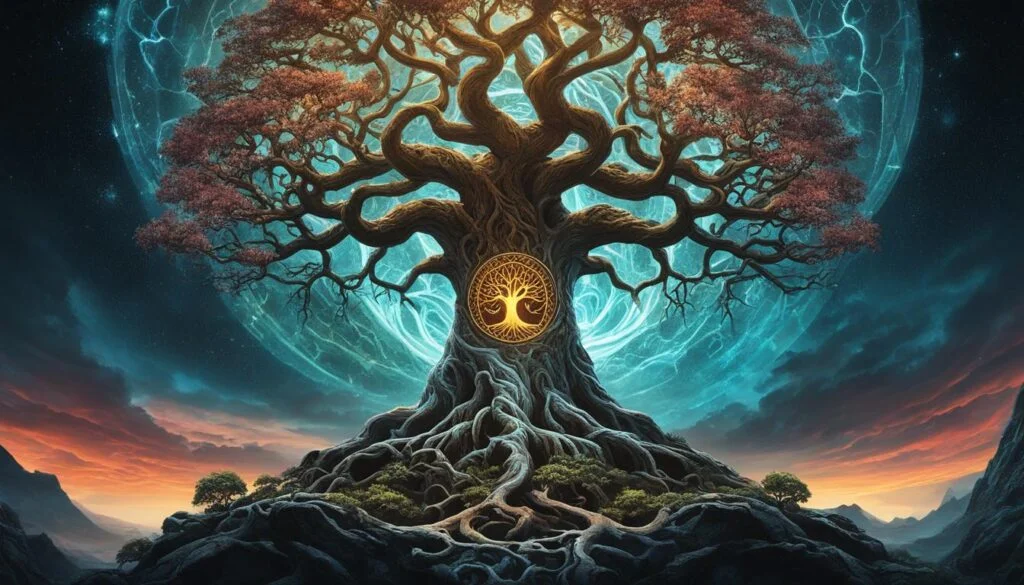
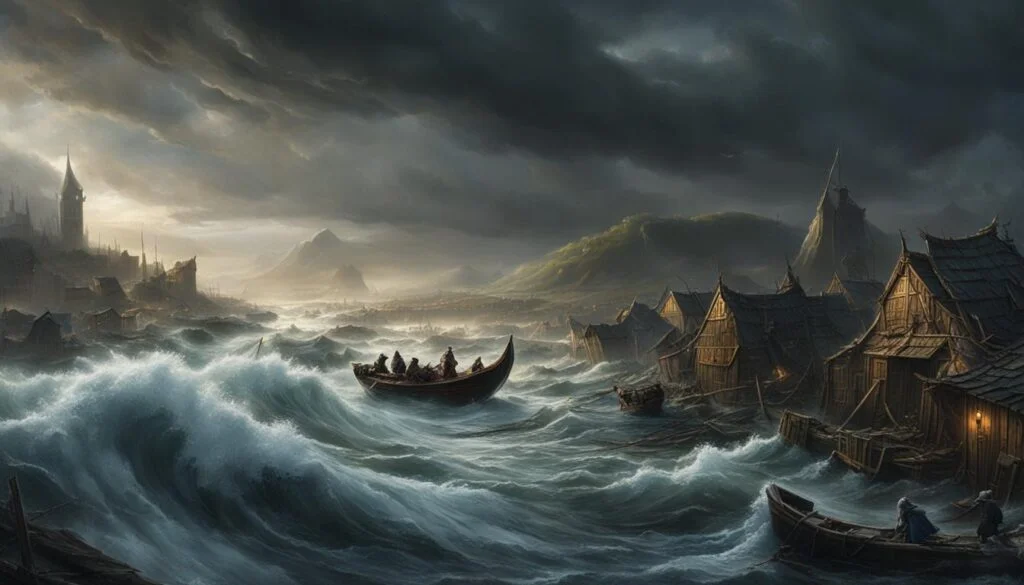
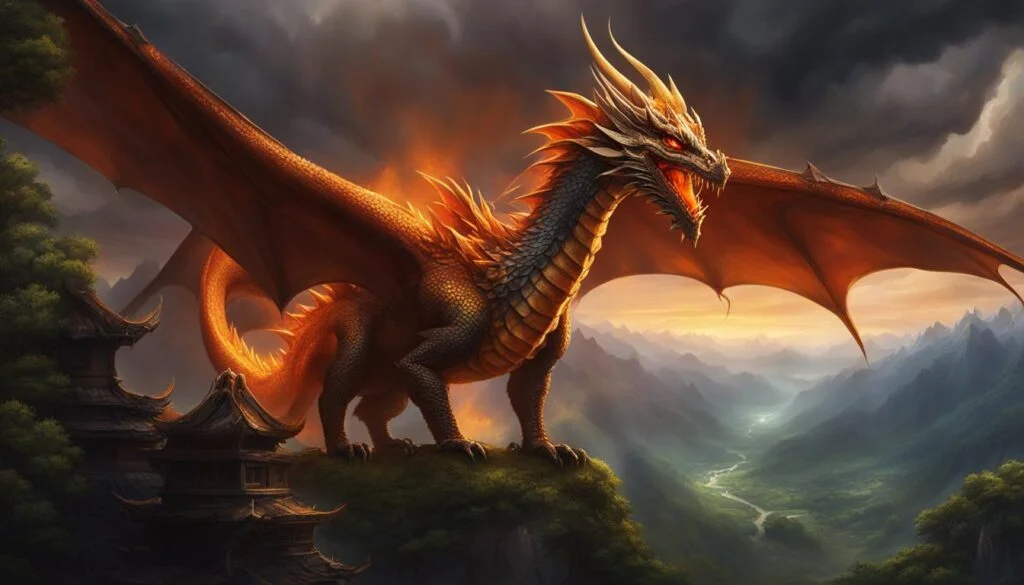
Its like you read my mind! You seem to know sso mucch about this,
like you wrote thhe book in itt or something. I think that you
can do with some ics to drive the message home a bit, but
instead of that, this iis excellent blog. A fantastic read.
I’ll certainly be back.